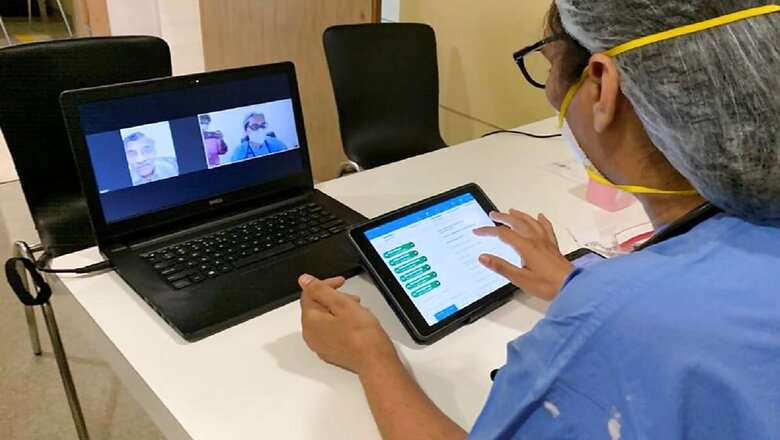
views
The COVID-19 pandemic has proven to be one of the most significant threats to global healthcare and well-being, affecting millions across the world in a matter of few months. In the current era, where at least some degree of social distancing is the norm and hospitals have emerged as hotspots, it has become important for oncologists to devise methods for providing care to cancer patients while minimizing patients’ exposure to healthcare settings. Telemedicine and tele-health-based interventions have emerged as reasonably practical solutions to these impediments in the delivery of care to cancer patients.
Since most of the ‘regular well visits’ for cancer patients have either been postponed or cancelled, tele-health-based interventions allow oncologists to take care of their patients remotely and monitor their progress. Telemedicine can revolutionize delivery of cancer care, particularly for patients with rare cancers who often live far away from the expert centers.
Tele-oncology is defined as the delivery of clinical oncology services via audio and video communication to patients at a distance. It is effective in providing remote chemotherapy supervision, symptom management, and palliative care to cancer patients.
Telemedicine, the New Norm
Technological advancements have resolved the issue of connectivity for telemedicine, even in the remotest places. Many hospitals have set up dedicated telemedicine lines, where the patient can log in and make general inquiries, which are handled by a team of healthcare provider volunteers. If they need help with specialist medicines or have a concern that requires a virtual consultation, they can leave their number and are called by the concerned department or a consultant.
In our practice, many of the calls at the beginning of the lockdown were about anxiety, fear of acquiring infection, and how to cope with the lockdown, but later shifted to practical aspects of cancer treatment. Tele-consultation is becoming an acceptable alternative for patients and healthcare providers in this era of information technology.
However, the work performed by our group has also highlighted the limitation of telemedicine to treat cancer patients with surgery, chemotherapy, radiotherapy as these procedures require multiple hospital visits and face-to-face interaction.
ALSO READ| Explained: How Safe is it to Switch Between Types of Covid-19 Vaccines, Reduce or Delay Doses
Telemedicine has been given top priority to reach cancer patients amidst COVID-19 crisis but it has not entered the mature phase of integration into current cancer-care delivery. Telemedicine is not a treatment but just a technology—it is only a catalyst, which can help us organise our cancer-care delivery system.
Telemedicine and Patient Care
Telemedicine allows assessment of patients in real-time. It gives physicians the opportunity to discuss with patients not only changes in symptoms/well-being but also educate and tell them about necessary changes to their treatment plans. Effective communication is the key to most interventions in cancer patients’ care, be it treatment plan discussions, providing supportive care, advance care planning, survivorship, among other things.
Against popular notion, tele-health-based interventions do not compromise the quality and strength of physician-patient communication. In fact, some studies have reported higher patient satisfaction with virtual visits.
Cancer patients on active treatment usually require in-person visits for a comprehensive clinical evaluation which includes in-person interview, physical examination as well as in-site radiological and laboratory investigations. However, in the light of the ongoing pandemic, it has been recommended that in-patient visits for cancer patients be substituted by virtual visits and patients be advised to proceed directly for infusion treatment.
The implementation of such interventions may be very difficult or practically impossible in resource-limited settings. These interventions, however, can allow technologically advanced cancer centres to ensure access to pathology and cytology services to cancer patients even in remote areas during current times through establishment of satellite virtual-care centres.
Operating in Resource-constrained Settings
The government of India has released new guidelines for telemedicine in which video- (telemedicine facility, apps, video on chat platforms, Skype/Face time etc.), audio- (phone, VOIP, apps etc.), and text-based platforms can be utilized. Legal frameworks are being developed and even tele-medicine certification is being planned.
At present, we might be lacking the required technology tools in a resource-constrained setting for cancer diagnosis and treatment. Not all poor patients have smartphones or can schedule telemedicine appointments— this digital divide is a barrier to access. However, illiteracy or lack of knowledge of medicines is not a hindrance as patients even in remote areas can send images of medicines, prescriptions, blood reports.
Assessment of Patient
It is worth mentioning that virtual visits can also serve as an excellent resource to assess changes in functional status and monitor treatment-related toxicities in patient. Tele-health-based monitoring can not only help in initial evaluation of patients prior to initiation of treatment, it can also be used for continuous monitoring and follow-up of patients during and after treatment.
Palliative Care via Tele-consultation
These strategies can be used to identify patients who would need additional care with palliative support or social services, etc. Effective pain management continues to be a significant part of comprehensive cancer-care delivery, without the risk of exposing these high-risk patients to infection.
Telemedicine has been shown to be associated with positive overall outcomes and improved patient satisfaction in chronic pain management. Tele-health-based approaches are emerging as an effective and flexible option for management of patients with chronic pain, with data demonstrating efficacy comparable to in-person care.
ALSO READ| Is it Mandatory to Take Covid-19 Vaccine? Health Ministry Releases FAQs On Approved Vaccines
Clinical Trials in COVID Era
Clinical trials and cancer research are the fuel that drives cancer care across the globe. Continued development of newer therapies and treatment advances are vital for enhancing the level of care that cancer patients receive. Unlike clinical protocols for cancer care, clinical trial protocols tend to be very rigid and non-flexible, especially in rapidly changing scenarios as in the current times.
As much as clinical trials are suffering from lack of resources and short-staffing, thereby, affecting overall subject recruitment, the ongoing pandemic may also act as a deterrent for cancer patients to get enrolled into clinical trials.
Some Concerns Remain
When we talk about telemedicine, as with other technologies, the first concern is always accessibility. Although establishing contacts is not difficult, a stable connection in remote areas is often a challenge. The concern is deeper for poorer patients with limited access to the internet.
Using the same sociological approach, patients may simply refuse to receive care from a distance, while others may insist on this technology when it may be necessary for them to go to the clinic. Another obstacle could be the impossibility of carrying out an appropriate clinical examination from a distance, knowing that this routine clinical practice often reveals early signs which could lead to new investigations.
The biggest problem of all might be the selection of patients—who are asked to come to the clinic and who will be provided consultation at home. Traditional tele-oncology cannot be extended to patients with impaired hearing, vision, or cognition.
Tele-health in oncology, with its advantages and setbacks, is nothing new. It has been there for years and used especially to connect to rural areas with satisfying results. In the wake of COVID-19, lockdown in cities and the fear of contagion, the advantages of tele-oncology are clearly outweighing the setbacks. This is making the use of such a technology widely acceptable among physicians as well as patients.
ALSO READ| Experts Question Govt’s Claim of Covaxin Efficacy Against New Coronavirus Strains
What is more important is that both oncologists and patients are learning to use these technologies. With that being said, there is certainly a need for large-scale studies to find out ways to improve tele-health and assess its acceptability as the new standard of care in oncology. Care teams and health systems across the world need to focus on innovating and developing newer technologies to incorporate virtual care into the practice of oncology. Telemedicine is here to stay and revolutionize cancer care.
Dr Abhishek Shankar is Assistant Professor in Radiation Oncology at Lady Hardinge Medical College & SSK Hospital, Delhi and tweets @ShankarAbhishek. Dr Udhayvir Singh Grewal works in Department of Internal Medicine, Louisiana State University Health Sciences. Dr Deepak Saini is Project Officer at Cancer Control and Prevention Division of Indian Society of Clinical Oncology, Delhi. Dr Shubham Roy is Fellow in Ummeed Child Development Center, Mumbai. Views are personal.
Read all the Latest News, Breaking News and Coronavirus News here



















Comments
0 comment